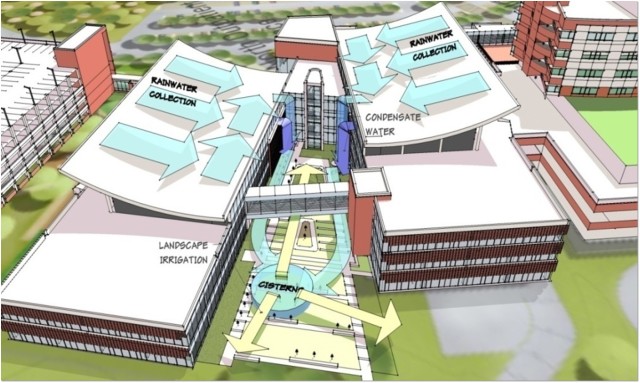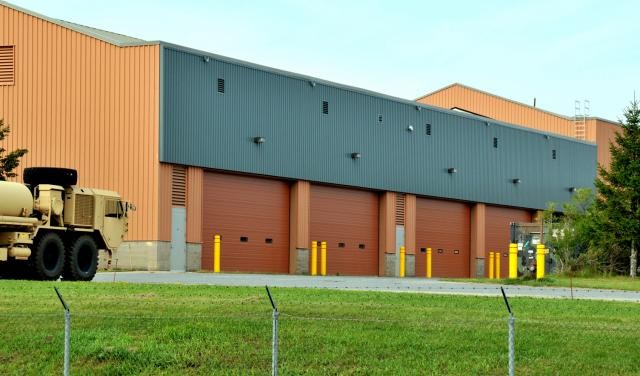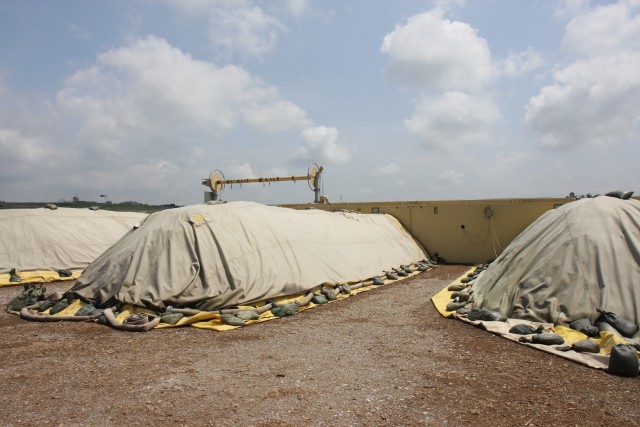WASHINGTON, March 11, 2011 -- U.S. Army installations frequently focus on improving energy efficiency, water usage and waste management practices in an effort become more sustainable to meet future military mission requirements.
Although all Army garrisons will develop their own comprehensive energy, water, and waste plans in support of the Army's net zero initiative, one fact remains clear: There is no single solution. The path to sustainability is not a single path at all, but one that runs in many directions at once.
The U.S. Army Corps of Engineers North Atlantic Division has helped installations in the Northeast and in Europe make progress down those paths by assisting them in implementing interdisciplinary solutions. Here are several examples of those services that North Atlantic Division, or NAD, has used to assist U.S. installations become more energy-, water- and waste-efficient.
1) Master Planning: Great installations and facilities don't just happen. To be great one must take inventory of resources and capabilities, establish realistic goals and develop a well thought out and coordinated path toward success. These are more than urban development plans.
For instance, compliance could require keeping vacant space for solar panels or composting yards. NAD's planning staff has helped many installations identify their master planning needs and develop cost-effective strategies for achieving them. Based on an installation's needs, we have prepared the statements of work and cost estimates, negotiated and managed contracted projects and prepared the plans with our in-house expertise.
2) Determine Air Tightness of Buildings: The more airtight a building is, the more energy efficient it will be. In 2009, USACE established new specifications for complete air and vapor barriers, forcing the industry to take a large step forward in improving quality construction by requiring new buildings to have less air leakage. Depending on climate, the total building energy cost savings due to improved building air tightness can range from five to 25 percent, making it a simple and relatively inexpensive step in reducing energy consumption. NAD, like all other divisions, has abided by the new standard.
3) Install solar electrical systems: As expensive as the initial outlay may be for a solar electrical system, the payback time for projects in NAD (with rebates and incentives) have been counted in years, not decades. For example, Fort Drum made a huge investment to install the world's largest collection of solar air heated buildings - via solar walls, not roofs - that heat vehicle maintenance buildings, hangars, and warehouses, but it will pay for itself in 10 years.
At the Sea Girt National Guard Training Center in New Jersey, a 20,000 square foot solar canopy installed not only provides shade for vehicles but also provides enough energy and renewable credits to pay for itself within 10 years.
"It's an excellent project," said retired Brig. Gen. Jeffrey L. Pierson, superintendent at the National Guard Joint Training Center. "Since it was installed we've saved $34,000 to $35,000 toward our electric bill, which is tremendous savings, especially during these tough times. The workmanship was excellent and the relationship with the [Army] Corps was great."
Most renewable energy projects are funded through the Energy Conservation and Investment Program, or ECIP.
4) Energy Conservation and Investment Program: ECIP is a centrally funded military construction program designed to improve energy efficiency at Department of Defense facilities while reducing associated utility energy and non-energy related costs. As a key component of DoD's energy management strategy, ECIP projects focus on energy and water savings, such as the solar canopy at Sea Girt, which NAD contracted through ECIP to reduce energy costs.
Funds are limited and projects compete based on savings-to-investment ratio and return on investment. The USACE Huntsville Center, which is not bound by geography, has helped the program gain national attention by initiating a five-year, $250 million design-build multiple award task order contract to provide ECIP contract acquisition and project management support DoD-wide.
The Huntsville Center has also established another multiple award task order contract for more complex energy savings projects, which will help USACE districts and installations in contracting with specialized firms more quickly. Both of these contracting options aim to use industry leading contractors to provide appropriate, turnkey solutions for clients who need to meet federal energy and water reduction targets.
5) Geothermal: Temperatures below the earth's surface remain nearly constant at 50 to 60A,AoF, even at chilly Fort Drum, NY, where so many successful geothermal systems have been installed that it is now the primary option for heating and cooling needs in all new construction projects, when feasible.
NAD has significantly reduced Fort Drum's heating and cooling bills by installing a geothermal heat exchange system in several buildings that require the installation to only need to rely on other methods of heating (most commonly gas or electrical) to heat the buildings the remaining few degrees to room temperature. Although not recommended for use in hangars or warehouses, geothermal heating is ideal for barracks and administrative buildings.
"We've got eight to ten of them completed on post now and it's the new standard," said Jim Corriveau, Fort Drum director of Public Works in April 2010.
6) Energy Savings Performance Contracts: ESPCs are unique contracts. They allow federal facilities to save energy and money at the same time by allowing a private contractor to provide capital to install energy-saving infrastructure. The contractor is paid through an agreed-upon monthly amount of guaranteed cost savings and can also take advantage of opportunities that the federal government cannot, including exploiting certain tax incentives, selling renewable energy credits and depreciating the property.
Any additional cost savings resulting from the new infrastructure can be added to the installation's bankroll free of charge. Other than a small supervision and administrative cost, all initial costs for the new infrastructure are funded by the contractor. This could include upgrading the existing heating, ventilation, electricity, or water systems; using renewable energy technology; installing better insulated windows and doors; or a combination.
The only criteria to qualify for an ESPC project is that the project generate savings to amortize within the life expectancy of the system. NAD recently executed a contract at the U.S. Army Garrison Vicenza, Italy, where Siemens AG installed a boiler plant that includes a co-generation unit that will simultaneously produce heat and power by using the escaping "waste heat" from electricity production to produce steam that helps heat the installation.
7) Low-cost renovations: Not all energy-saving systems require new construction. NAD has assisted many garrisons in the Northeast and Europe with energy-saving renovations, including installing radiant floor heat; adding wall and ceiling insulation; upgrading windows, doors, and garage doors; installing motion-activated light-emitting diodes; and replacing existing materials with green or recycled materials.
Special tax deductions are now available for contractors working on installation-level energy savings projects such as climate control and lighting upgrades as part of the Army's Building Energy Efficiency tax Deduction Policy, signed Dec. 17, 2010.
8) Storm water management: Effectively managing storm water on installations can be difficult, especially those with large areas of impermeable pavement, such as motor pools and parking lots. But many options for storm water harvesting or black water recycling exist and have been contracted out through NAD either at the installation level (such as through a storm water retention system) or at the individual project level (such as through green roofs).
One high-profile project with a unique method for rainwater collection is the new Fort Belvoir Hospital, which has two swooped roofs that collect rainwater in underground cisterns for reuse in irrigation.
"These collect rainwater and pour the rainwater down into a cistern that feeds the gardens in between the buildings," explained Dr. Richard Repeta, director of the Dewitt Health Care Network's Integration and Transition Office in 2007. "It prevents the run-off and also acts in an environmentally sound way of using that water for local plants."
Other options for water reduction that NAD has assisted with include contracting to install low-flow plumbing fixtures, plant drought tolerant native plants, or simply installing rain storage tanks.
9) Composting: If reducing waste is your target, new advances to the millennia-old technique of composting now allow for the production of cheap, clean mulch by using the sewage sludge and food waste generated from an installation in addition to chipped wood, paper, cardboard, and yard trimmings.
A few years ago in Camp Bondsteel, Kosovo, NAD contracted out for a "mobile aerated static heap" composting system that produces high-quality mulch in about six weeks. It can be used as a base for new landscaping or to aid with erosion control.
"Honestly, I can't imagine a better process than what we're doing right here for getting rid of organic waste," said Greg Taylor, environmental specialist for the USACE Europe District, in 2006.
10) Utility studies: Utility studies analyze the physical and operational condition of water distribution, power distribution, sewer and other utility systems to determine the level of deterioration or disrepair and to identify ways to save utility costs and reduce operating costs.
NAD has helped our customers' assess needs and determine scopes of work, time schedules, and estimated study costs. Most districts have in-house, qualified technical experts who can prepare the utility study or use the expertise of special consultants. A utility study can provide necessary data to prioritize and program repairs and upgrades. It can also identify and advise on how to minimize or eliminate potential or existing health and environmental hazards.
Depending on the scope and condition of the system, the study can take a few weeks to a few months. An estimate of the time requirements can be provided upon request.
11) One-stop program: One-Stop funds give Army appropriated facilities access to specialized master planning, programming, environmental, engineering and architectural skills at no cost to them. The service is centrally funded to help garrisons better identify problems and potential solutions in areas where further engineering assistance is needed.
NAD most commonly provides condition inspections and small project design, but can also provide utilities privatization support, real estate support, and 1391 preparation support. Normally an NAD representative determines the scope of work and arranges an appointment (telephone or site visit) to review the problem.
The scope of effort is limited to 24 hours of actual effort (travel doesn't count), however hours can be increased if approved by the One-Stop coordinator. Documentation of findings are always be provided. Because funds are limited, requests are provided on a first-come, first-served basis until all annual One-Stop funds are spent.
Funds are OMA and cannot be used to directly support Air Force, DoDDS, DECA or NAF.
Other USACE services that NAD can offer to help installations meet conservation goals include real estate services to sell excess property, energy audits, economic analyses to determine the financial impact of several alternatives, feasibility studies on small-scale waste-to-energy systems, and even mapping services to get a good grasp of facility utilization.
Installations looking for the best USACE point of contact should refer to the USACE locations page at http://www.usace.army.mil/about/Pages/Locations.aspx.
Related Links:
Energy Conservation Investment Program
STAND-TO!: Office of the Assistant Secretary of the Army for Installations, Energy and Environment
U.S. Army Corps of Engineers Engineering and Support Center Huntsville








Social Sharing